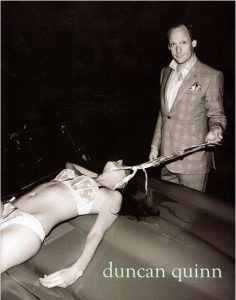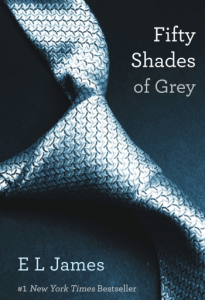 I have chosen the image of Duncan Quinn, whose advertisement caused controversy with the media. The photograph depicts a smug male character, pulling his tie which is wrapped around a dead female, lying on what is presumably his convertible car.
I have chosen the image of Duncan Quinn, whose advertisement caused controversy with the media. The photograph depicts a smug male character, pulling his tie which is wrapped around a dead female, lying on what is presumably his convertible car.
The male character wears a slick, expensive suit by Duncan Quinn, which makes his appearance seem powerful and professional. It is to be assumed that he has removed his tie from around his neck and used this to strangle and detain the woman. When researching the advertisement further, I came across a blog written by Deig. L. 2011, which discusses the concept that the tie is a phallic symbol. Considering this point stated in the blog, I agree that the tie represents phallic power and male dominance. The way the photograph has been taken presents the audience with the impression, that the man has been caught, possibly by Police, as the black background makes the dominant male stand out, as if a flashlight is highlighting his criminality. He seems to be pleased that he has been caught as, it shows the power he has over the innocent woman.
The woman in the advertisement lies lifeless on the bonnet of the car. She has been stripped of her innocence as she appears to have been raped. The woman is photographed in her white underwear, which is known to represent innocence, purity and virginity. The colour white represents cleanliest, which contradicts the blood stained car bonnet. As the female isn’t naked, it could be considered that the advertisement wanted to represent respectfulness rather than, a symbolism of sex.
The advertisers of Duncan Quinn have portrayed the idea their suits provide power and authority. However, this has had the adverse effect as, the advertisement has desensitised the idea of abusive relationships/rape and seems to promote abusive behaviour and sadomasochistic activity.
What effect did Malcolm Barnard want the advertisement to have? When the suit was originally designed, did designers want their suit to be an advert of abusive, indecent, sexual offences? A contradiction to this argument is stated in: “Fashion as Communication” by Malcolm Barnard. It states “the designer, the buyer, the wearer and the audience all contribute to creating and transforming the messages that are communicated by means of fashion and clothing”. In our society now, these images are seen more frequently. I wouldn’t be surprised, if the whole advertisement was created to shock viewers.
The recent trilogy “Fifty Shades of Grey” supports the advertisement as it presents both characters: the dominant, powerful male, and the innocent, pure female. Christian Grey is seen to be a dominant male, who wears expensive, fitted suits, very much like the gentleman in the photograph. Mr Grey seduces Miss Steele, who is transformed from an innocent virgin to a submissive. Like the advertisement, it could be said that Miss Steele was a victim of sexual assault. However, the contrast between the Fifty Shades of Grey dramas, and the advert is that Miss Steele consented to the S&M activities. In contrast, it appears that the woman in the advert has been killed. From the facial expressions of the gentleman, he seems pleased that he has murdered the woman.
Grey is seen to be a dominant male, who wears expensive, fitted suits, very much like the gentleman in the photograph. Mr Grey seduces Miss Steele, who is transformed from an innocent virgin to a submissive. Like the advertisement, it could be said that Miss Steele was a victim of sexual assault. However, the contrast between the Fifty Shades of Grey dramas, and the advert is that Miss Steele consented to the S&M activities. In contrast, it appears that the woman in the advert has been killed. From the facial expressions of the gentleman, he seems pleased that he has murdered the woman.
Do we have to accept that this behaviour is occurring, whether it highlights a woman’s vulnerability and a male’s dominance?
Bibliography
- James.E.L (2017) Fifty Shades of Grey. [Online website] Web address: http://www.eljamesauthor.com/books/fifty-shades-of-grey/
- Winn. S. (2008) Trend Hunter. [Online website] Web address: https://www.trendhunter.com/trends/duncan-quinn-suit-ad-depicting-strangled-woman
- Deig. L.(2011) Blog post – Suit Up [Blog post found online] https://ldeig.wordpress.com/2011/02/03/assignment-2-suit-up/
- Barnard. M. (1996) Fashion as Communication London: Routledge.
